The commercial scallop fishery originated in the Clyde during the early 1930s but developed rapidly during the late 1960s and early 1970s, expanding to other west coast grounds. Fisheries around Shetland and in the Moray Firth also developed over this period, followed by those off the east coast of the Scottish mainland in the 1980s. Fishing takes place all year round with more than 80 per cent of Scottish landings coming from grounds West of Kintyre, North West, Shetland, North East and on the East coast. Most scallops are caught by vessels using arrays of specialised dredges attached to bars towed from either side of the vessel. The scallop fleet is roughly divided into two groups: smaller vessels that tend to work locally in inshore waters; and fewer larger vessels up to about 30 m in length, with the capability to fish offshore grounds and venture more widely around the coast of Scotland and the UK. Scallops are also fished commercially by divers, accounting for about five per cent of the landings.
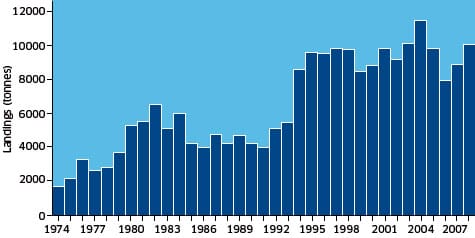

Biology and life cycle
Scallops are bivalve molluscs that live in the waters around Scotland and its islands, the North Sea, and the Atlantic. They can be found on the seabed anywhere from just below the low water mark to depths exceeding 100 m, preferring sediments comprised of sand, gravel and mud, sometimes interspersed with stones, rocks or boulders. They filter feed on suspended phytoplankton, algae, and other micro-organisms. If undisturbed, scallops usually lie recessed into the sediments with their flat valve uppermost, often disguised by a layer of sediment with only their eyes and tentacles visible when the valves are open. They have numerous eyes around the shell margin. Each is capable of forming an image which, along with other well developed sense organs, make scallops highly sensitive to changes in their immediate surroundings.
Although considered sedentary, scallops are able to swim limited distances propelled by jets of water. The jets are produced by rapid closure of the valves and can be redirected to aid recessing. Scallops are hermaphrodites and release male and female gametes separately into the surrounding water. Spawning is synchronized with scallops nearby improving the chances of successful crossfertilisation. Fertilised eggs develop over a period of 24 to 48 hours into free-swimming larvae that migrate towards the sea surface, spending three weeks or more in the water column. Larvae eventually settle on to the seabed, often becoming attached to the substrate before undergoing final metamorphosis into their adult form. Larvae are affected by water circulation and tides , as well as wind driven currents when they are near the surface. This makes it very difficult to predict where they eventually settle, which may be some distance from the parent population.
In Scottish waters, scallops spawn for the first time in the autumn of their second year, and subsequently spawn each year in the spring or autumn. After settlement, scallops grow until their first winter during which growth usually ceases. Thereafter, growth resumes each spring and ceases each winter causing a distinct ring to be formed on the external surface of the shell. These are annual growth rings which can be used to determine the age and growth rate of scallops. In biological terms the length of a scallop is the maximum dimension parallel to the hinge, and in Scotland scallops grow to lengths exceeding 175 mm and can live for 20 years or more. Environmental factors such as water temperature and food availability affect growth rates, which vary between areas.
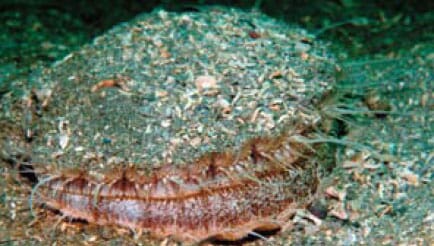
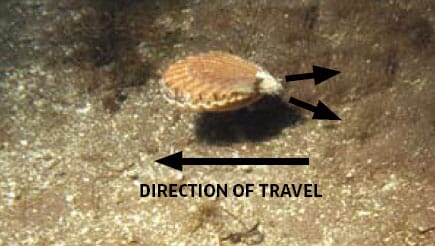
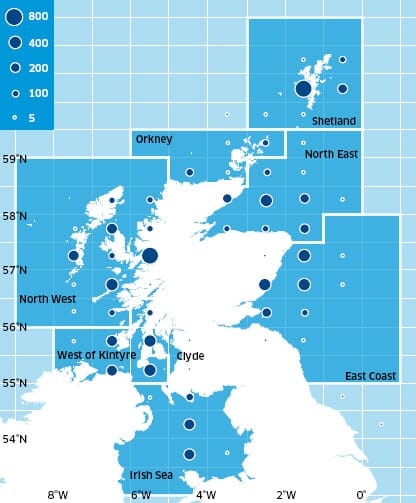
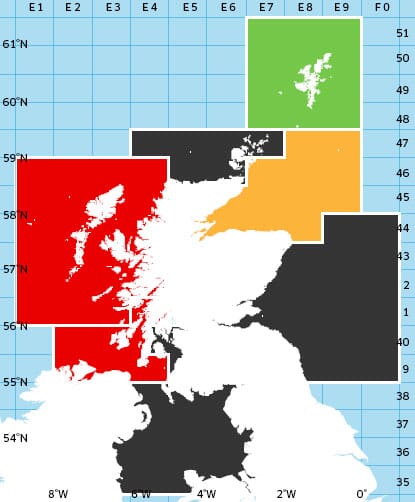

Management advice
For scallops current EU legislation specifies a minimum landing size of 100 mm length, but there are no limits in the form of TACs or quotas. In Scotland, additional management measures specific to the scallop fishery have been introduced to support sustainable exploitation. In 1999, a restricted scallop licensing scheme was introduced in response to concerns about the expansion of scallop fishing effort.
The scheme was strengthened in 2003 by gear restrictions that vary according to where fishing takes place: a maximum of eight dredges per side can be towed in Scottish inshore waters (out to six nautical miles); a maximum of 10 per side in any other part of the UK territorial sea adjacent to Scotland (out to 12 nautical miles); and 14 per side in any other part of the Scottish zone (out to 200 nautical miles).
Additionally, the use of ‘French’ dredges (a design incorporating water deflecting plates and rigid fixed teeth) is prohibited in Scottish inshore waters. Technical measures for the management of scallop fishing are currently under review by the scallop strategy group, a subgroup of the Scottish Fisheries Council.

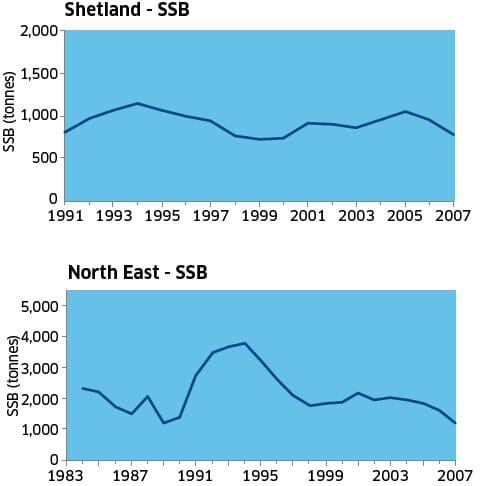
Assessment
A combination of methods is used to assess scallop stocks. For the stocks in the main scallop management areas: West of Kintyre; North West; Shetland; and North East, an aged structured method, Virtual Population Analysis (VPA) is the approach used. The VPA uses reported landings data along with age and length frequency data which are collected as part of the Marine Scotland Science market sampling programme.
The VPA provides annual estimates of yield, fishing mortality, spawning stock biomass and recruitment. In addition, Marine Scotland Science carries out annual scallop dredge surveys on the east and west coasts of Scotland and around Shetland. The surveys complement the VPA as they provide information on the most recent changes in abundance, recruitment, age structure, growth rate, and other biological data. For the East Coast area the survey catch rate data are the main source of information on stock dynamics. Stocks in the Irish Sea, Orkney, and the Clyde are not routinely surveyed and there are insufficient data for VPAs – official landings and market sampling data are monitored.
State of the stocks
The outputs from the VPA indicate that spawning stock biomass (SSB) in the West of Kintyre and the North West management areas has declined to low levels, when compared to historical values, and in the North West is the lowest observed (estimated). In the North East SSB has also declined from relatively high values in the mid-90s, but similar to the situation in Shetland, has been relatively stable in recent years. These patterns are mirrored by trends in the survey catch rate data of commercially sized scallops (those above 100mm) although, following a historically low catch rate in 2007, the North East area showed an improvement in 2008 (data not shown).
In the East Coast management area, which is not assessed using VPA, the surveys show an increase in the catch rate of scallops above 100 mm. Recruitment, as estimated by the VPA for the West of Kintyre, North West, North East and Shetland management areas indicate that recruitment has declined to low levels in recent years, when compared to historical values. This trend is borne out by survey catch rate data of scallops below 100 mm which have declined in all areas, including the East Coast.
Management advice
There are no agreed targets for scallop stocks. During the current period of low spawning stock biomass and reduced recruitment, advice is for no increase in fishing effort and measures aimed to increase spawning stock biomass. One such measure under consideration is an increase in the minimum landing size. The survival of discarded scallops is high and therefore most undersized scallops returned to the sea have the potential to grow, increasing the spawning stock biomass and the reproductive capacity of the stock and, potentially, future recruitment.
July 2010
